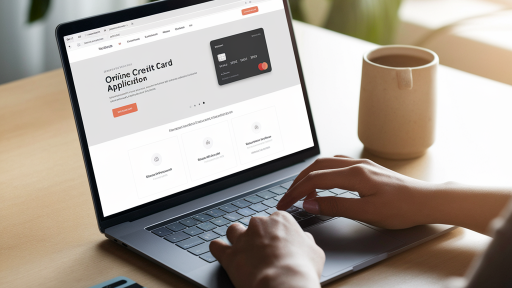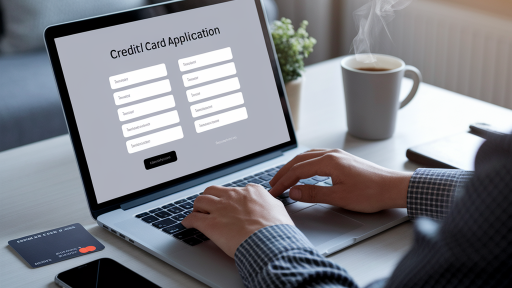In today’s fast-paced digital world, convenience is king. From ordering groceries to booking a vacation, we do almost everything online, and applying for financial products is no exception. The idea of getting a new credit card without ever leaving your couch is undeniably appealing, offering instant comparisons and quick decisions.
But with this convenience comes a crucial question that lingers in the back of many minds: Is it truly safe? Handing over your most sensitive personal information—like your Social Security number and income details—to a website can feel like a leap of faith. The good news is that it can be incredibly safe, provided you arm yourself with the right knowledge and follow essential security protocols.
The Digital Shift: Why Online Credit Card Applications Are the New Norm
The move from paper applications to digital forms isn’t just about convenience; it’s a fundamental shift in how we interact with financial institutions. Banks and credit card issuers have invested heavily in creating streamlined, secure online platforms. This transition benefits consumers in several ways, including faster approval times, a broader selection of cards to compare, and access to exclusive online-only offers. For lenders, it means a more efficient, automated process that reduces paperwork and overhead.
This digital-first approach has made the credit market more competitive and accessible. However, it also places a greater responsibility on the user to be vigilant. Understanding the landscape—both the opportunities and the potential threats—is the first step toward a secure application process.
Understanding the Risks: What Could Go Wrong?
While financial institutions use advanced encryption and security measures, cybercriminals are constantly developing new tactics to exploit vulnerabilities. Being aware of the potential risks is not meant to scare you, but to empower you to recognize and avoid them. Here are the primary threats you should be aware of when applying for a credit card online.
Phishing Scams and Fake Websites
Phishing is one of the most common online threats. Scammers create emails, text messages, or social media ads that look like they’re from a legitimate bank or credit card company. These messages often contain urgent calls to action—like “Your account is at risk, verify it now!” or “Claim your pre-approved card today!”—with a link that leads to a fraudulent website designed to mimic the real one. If you enter your personal information on one of these fake sites, it goes directly to the criminals.
Data Breaches
Even when you apply on a legitimate website, the danger isn’t entirely gone. Data breaches occur when hackers successfully infiltrate a company’s servers and steal the user data stored there. While you can’t prevent a company from being breached, you can choose reputable institutions with a strong track record of security and take steps to minimize the potential damage if a breach does occur.
Insecure Networks (Public Wi-Fi)
Applying for a credit card while sipping a latte at your favorite coffee shop might seem convenient, but it’s a significant security risk. Public Wi-Fi networks are often unencrypted and not secure. This means that a skilled hacker connected to the same network could potentially intercept the data you send, including your name, address, and financial details. This type of attack is known as a “man-in-the-middle” attack.
Identity Theft
Identity theft is the ultimate risk of a compromised online application. If a criminal gets enough of your personal information, they can do more than just use your credit card. They can open new credit cards, take out loans, and commit other forms of fraud in your name, potentially ruining your credit score and causing immense financial and legal problems that can take years to resolve.
Your Pre-Application Security Checklist: 7 Steps to Take Before You Apply
Preparation is your best defense. Before you even start typing your information into a form, follow these critical steps to ensure your application process is as secure as possible.
- Secure Your Connection: Never apply for a credit card over a public or unsecured Wi-Fi network. Always use a private, password-protected network, such as your home or trusted work connection. Additionally, verify that the website address begins with “https://” and displays a padlock icon in the browser’s address bar. The ‘S’ stands for ‘secure’ and indicates that the data transmitted between your browser and the website is encrypted.
- Verify the Issuer’s Legitimacy: Scammers are experts at creating convincing fakes. Before applying, do your due diligence. Search for the credit card issuer independently. Check for a physical address, a customer service phone number, and professional branding. Be wary of offers that seem too good to be true, as they often are.
- Go Directly to the Source: Avoid clicking on links in unsolicited emails, pop-up ads, or text messages. The safest method is to manually type the financial institution’s official URL directly into your browser’s address bar. This bypasses any potential phishing links and ensures you land on the real website.
- Read the Fine Print (Terms and Conditions): While not a direct cybersecurity tip, this is a crucial part of financial safety. Understand the card’s Annual Percentage Rate (APR), fees (annual fee, late fees, foreign transaction fees), and rewards program. A legitimate offer will always have these terms clearly accessible before you apply.
- Prepare Your Documents Securely: Know what information you’ll need (e.g., full name, address, date of birth, Social Security number, total annual income) and have it ready. Be suspicious if an application asks for information that seems irrelevant, such as your bank account password or social media login details.
- Check Your Credit Report: Before applying for new credit, it’s a good practice to review your credit report from all three major bureaus (Equifax, Experian, and TransUnion). This allows you to spot and dispute any inaccuracies or signs of existing fraudulent activity. In the U.S., you can get free copies from the government-authorized site, AnnualCreditReport.com.
- Use a Secure Device: Ensure the computer, tablet, or phone you’re using is secure. This means having up-to-date antivirus and anti-malware software installed, running a modern web browser, and ensuring your operating system has the latest security patches installed.
During the Application: Best Practices for Filling Out the Form
Once you’ve done your prep work and are on the secure application page, maintain your vigilance. Pay close attention to the details as you fill out the form.
Look for Security Indicators
Continuously check that the “https://” and padlock icon remain visible in your browser’s address bar throughout the entire application process. Some fraudulent sites might have a secure homepage but redirect to an insecure page for the actual data entry.
Be Wary of Information Requests
A credit card application will require sensitive information, but there are limits. Understanding what’s normal versus what’s a red flag is key.
| Information Type | Standard & Necessary Requests | Red Flag / Suspicious Requests |
|---|---|---|
| Personal Details | Full Name, Date of Birth, Social Security Number (or equivalent), Phone Number, Email Address | PINs for existing bank accounts, Social media passwords, Answers to security questions for other websites |
| Address & Housing | Current Physical Address, Time at Address, Housing Status (Own/Rent), Monthly Housing Payment | Requests for photos of your home, Landlord’s personal phone number |
| Financial & Employment | Employment Status, Employer Name, Total Annual Income, Source of Income | Your full bank account number (unless setting up direct debit for payments after approval), Login credentials for your bank account |
Create Strong, Unique Passwords
If the application process includes creating an online account to manage your card, you’ll need to set a password. Don’t reuse passwords from other sites. A strong password should be long (at least 12-15 characters) and include a mix of uppercase letters, lowercase letters, numbers, and symbols. For more guidance, you can refer to resources on creating strong passwords from cybersecurity experts.
Save a Copy for Your Records
After you submit the application, you’ll typically land on a confirmation page with an application ID or reference number. Save a copy of this page as a PDF or take a screenshot. This is useful for your records and can be important if you need to follow up on your application status.
After You Apply: Protecting Yourself Post-Submission
Your security diligence shouldn’t end when you click “submit.” The period following your application is a critical time to monitor for both legitimate communications and potential signs of fraud.
- Monitor Your Email: You will receive emails from the issuer regarding your application status. Learn to distinguish these from phishing attempts. Legitimate emails will address you by name and often reference your application ID. They will not ask you to provide your full Social Security number or other sensitive data via email.
- Check Your Credit Report Again: When a lender checks your credit, a “hard inquiry” appears on your report. Monitor your report in the days following your application to ensure the inquiry is from the company you applied with. Also, keep an eye out for any inquiries you don’t recognize, which could be a sign of identity theft.
- Shred Unnecessary Documents: If you wrote down any sensitive information on paper while preparing your application, be sure to shred it thoroughly once you are finished.
- Plan for Your New Card: When your new card arrives in the mail, sign the back immediately. Call the activation number from a secure phone line and shred the sticker with the activation number on it.
Comparing Secure vs. Unsecure Application Scenarios
To put it all together, here’s a clear comparison of what a secure application process looks like versus a highly insecure one.
| Feature | ✅ Secure Scenario | ❌ Unsecure Scenario |
|---|---|---|
| Website URL | Starts with “https://”. You typed the URL directly into the browser. | Starts with “http://”. You clicked a link in an unsolicited email or ad. |
| Connection Type | Private, password-protected home or work Wi-Fi. | Free, public Wi-Fi at a café, airport, or library. |
| Information Requested | Asks for standard information needed to assess creditworthiness (SSN, income, etc.). | Asks for your bank account PIN, social media passwords, or other irrelevant, highly sensitive data. |
| Communication Method | You initiated the application on the official, verified website. | You were pressured by a pop-up ad or an urgent-sounding email to “act now.” |
The Verdict: Is It Safe to Get an Online Credit Card?
So, we return to our original question. The answer is a resounding yes, it is safe to get an online credit card, but with a major condition: safety is an active process. It relies on a partnership between the financial institution’s security systems and your own cautious, informed actions.
By following the security tips outlined—securing your connection, verifying the source, protecting your data, and monitoring your accounts—you can confidently navigate the digital application process. The convenience of applying for credit online is a powerful tool for modern financial management. When you approach it with a security-first mindset, you can reap the benefits while dramatically minimizing the risks.
Ultimately, the digital world is not something to be feared, but to be understood. By educating yourself on best practices, you can protect your identity and financial well-being. To further protect yourself, it’s wise to review official guidance on avoiding scams. The Federal Trade Commission provides extensive resources that help you understand what to look for and how to react, which is a key part of learning how safe it is to get an online credit card and manage your digital footprint responsibly.




